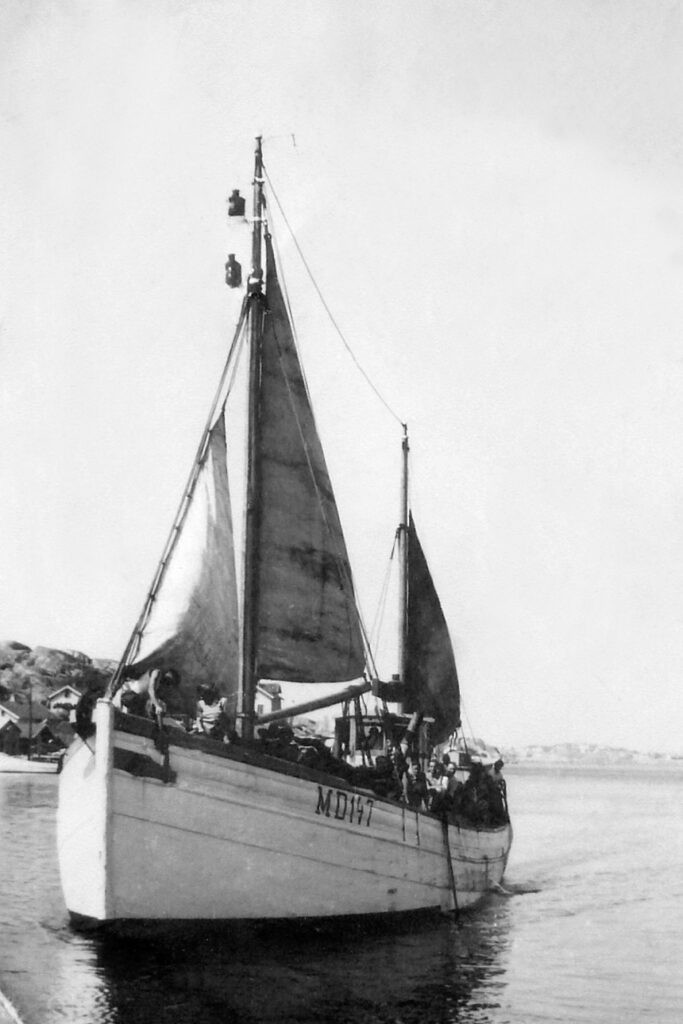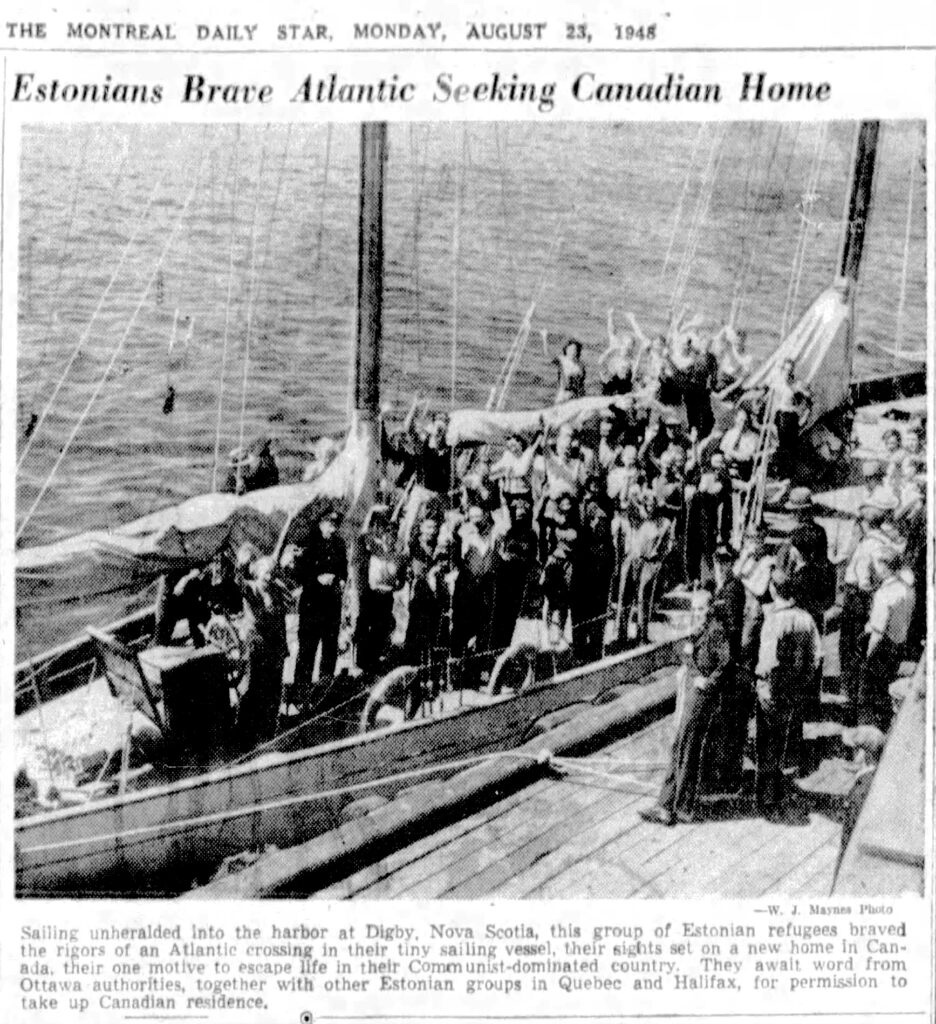Boats

Fiskebåten Östervåg.
ÖSTERVÅG
Östervåg var den fjärde baltiska flyktingbåten som kom till Kanada. Båten anlände till Halifax 22 augusti 1948, bara två dagar efter Capry. Evald Past, båtens kapten, hade tagit examen från Tallinn sjöfartsskolas första årskull 1924 och var en välkänd sjöhistoriker innan andra världskriget. 1944 flydde han till Sverige med sin familj och arbetade på svenska skepp fram tills 1947.
År 1948 samlade Past och fyra andra ester ihop sina resurser för att köpa Östervåg för 55 000 svenska kronor. Båten var en fiskebåt byggd 1890 i Grimsby, England, vägde 62 ton, var 21.5 meter lång och sex meter bred, och utrustad med en 135 hk motor. Östervåg var samma slags Nordsjö-trålare som Prolific, ytterligare en flyktingbåt som seglade från Uddevalla till USA några dagar tidigare.
Kapten Past ägde 29 av 100 andelar i Östervåg. Toivo Neemre köpte 20 andelar, Jaan Järv 18, Helmer Mäsak 18 och Lembit Jänes 15. Under Pasts ledarskap pågick förberedelser för resan i Rönnängs hamn, norr om Göteborg.
Omkring klockan 21 den 28 juli 1948 seglade Östervåg ut ur Marstrands hamn efter att ha fått godkännande för avfärd av svenska tullmyndigheten. 75 flyktingar var ombord, inklusive 15 barn. Där fanns 71 ester, tre polacker, och en karel. Besättningen förlitade sig på “en klocka, en kompass och en gammaldags sextant” för att navigera sig till Skottland, enligt en tidningsartikel från Halifax Mail publicerad den 18 augusti.
Halifax Herald publicerade intervjuer med kapten Past under och efter resans gång. Den 3 augusti, under stoppet i Skottland, meddelade han att “… det finns många estniska flyktingar måna om att resa till Kanada från Sverige. Det är för varmt där nära Ryssland.” Efter att ha nått Kanada den 21 augusti sa han “…vi såg ryssarna en gång och vi såg tyskarna en gång, och vi flydde från våra hem eftersom vi visste att när tyskarna lämnat skulle ryssarna komma igen och det skulle vara dåligt. Vi känner ryssarna.”
Kapten Past hade planerat resan noggrant. Bekymrad över sovjetiska krigsfartyg som patrullerade Engelska kanalen och från historier han hört om kidnappade flyktingar utvecklade han två rutter: en officiell som gick genom Engelska kanalen och den han faktiskt använde som gick genom Skottland med ett stopp i Stornoway. Eftersom båten Astrid hade lagt till där bara några dagar tidigare, var stadsbefolkningen och borgmästaren bekanta vid flyktingarnas erfarenheter och välkomnade dem genom att erbjuda dem hjälp och mat.
I Stornoway, fick flyktingarna uppleva ett lyckligt sammanträffande som senare gjorde det lättare för dem att få visum i Kanada.
Alexander E. Kerr, rektor på Dalhousie University i Halifax, Kanada, var på semester i närheten och fick höra talas om flyktingbåten och dess planer att segla till Kanada. Han besökte båten och frågade hur han kunde bistå dem. Kapten Pasts enda förfrågan var om hjälp att få tillstånd att lägga till i Kanada, vilket Kerr lyckades ordna.
När Östervåg gjorde sig färdig för avsegling, steg en brittisk inspektör ombord båten och dömde att den inte var sjövärdig att korsa Atlanten med så många passagerare ombord. Han tillät den att lämna hamnen bara om Past seglade tillbaka till Sverige. Past gick med på detta men så fort skeppet lämnat Stornoway den femte augusti vände han båtens för västerut och korsade Atlanten.
Kapten Pasts ursprungliga plan var att segla direkt till Halifax men en manlig passagerare hade inte ätit på åtta dagar till följd av sjösjuka, så den 17 augusti lade båten till i hamnen i Saint John som var närmre. Östervåg hade korsat Atlanten på bara tolv dagar, trots att ha seglat i motvind mot slutet. Passageraren återhämtade sig och skeppet fortsatte segla nästa dag, och nådde Halifax 22 augusti. Hela sjöresan hade tagit 25 dagar.

The Montreal Star, Kanada, 28 augusti 1948.
Efter landstigning, spenderade flyktingarna två månader på en migrationsanläggning där bakgrunds- samt medicinska kontroller genomfördes. Den 15 oktober tilläts passagerarna ombord Astrid, Atlanta, Capry och Östervåg, vilka alla hade anlänt under en tio dagars period att lagligt anlända till Kanada.
Innan de lämnade Halifax anordnade Östervåg och Caprys passagerare en avskedsfest med över 300 gäster. Efteråt slog sig majoriteten av de estniska flyktingarna ner i Toronto, där många ester redan hade bosatt sig.
Kända besättningsmedlemmar och passagerare:
- Kapten Evald Past
- Toivo Neemre
- Jaan Järv
- Helmer Mäsak
- Lembit Jänes
Fotografi används med tillåtelse av Estniska sjöfartsmuseet.
